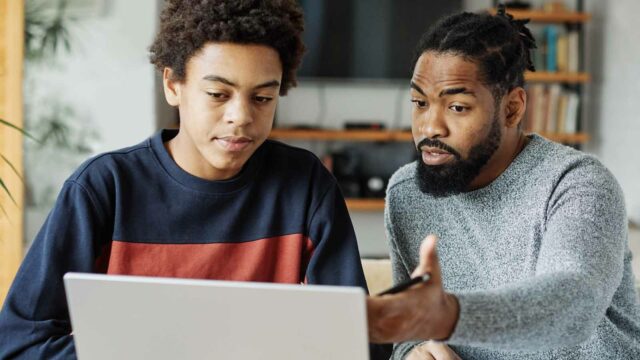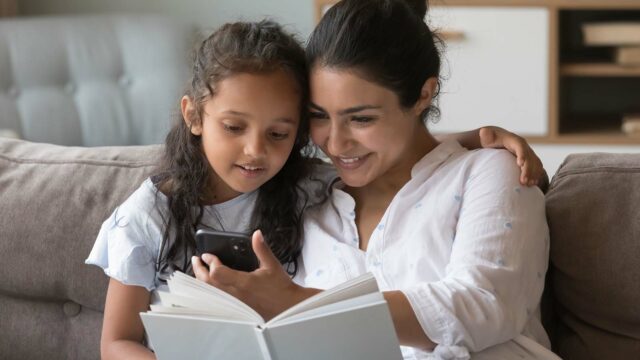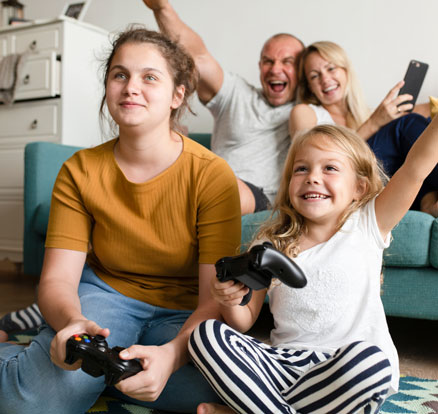
Porn, kids and media
More and more young people are watching porn. Some are watching it for the first time at primary school age. However, young people themselves believe that they are affected by porn for better or for worse. Here you can read the facts and advice on this topic.
Choose language in the Google-box below. Some translations may be flawed or inaccurate.
Facts and information
The word pornography derives from the two Greek words “porne” and “graphein.” Porne means prostitution, i.e., selling sex, and graphein means something that is written or illustrated.
Porn can comprise images, videos, and games aimed at creating sexual arousal in the recipient.
It’s natural to be curious about sexuality when children reach their teens and need information. Many young use pornographies as a source of that information.
The content of pornography ranges from so-called mainstream sex to crude and offensive depictions of violence directed mainly toward women. This can create unrealistic realizations and expectations about sex, and in the worst case, make young people more insecure.
If porn is used as the only information channel about sex, one might easily get the wrong picture of sexuality. Pornography doesn’t help young people know how to express their own desires and set boundaries. They may also struggle to understand what is normal and what is extreme/abnormal. Porn rarely shows consent to the sexual acts performed in the videos.
Selected facts:
The Children and Media Survey of the Norwegian Media Authority (2022) shows that more than half of 13-18-year-olds have watched porn (52 percent). There are twice as many boys who watch this type of content compared to girls. At the same time, there is a noticeable difference in age and gender for young people who say they have watched porn:
- 24 percent of girls and 55 percent of boys aged 13–14 have watched porn.
- 35 percent of girls and 66 percent of boys aged 15-16 have watched porn.
- 39 percent of girls and 79 percent of boys aged 17-18 have watched porn.
Among the youngest of both sexes, there are many who have not watched porn. And the proportion of boys who watch porn is significantly higher than girls of all age groups.
Furthermore, 55 percent of 13-18-year-olds who have watched porn online state that they watched porn for the first time before the age of 13. The corresponding figure in 2020 was 57 percent.
Age of children when they first time watched porn (those who have responded that they have watched porn):
- 6 years or younger (5 percent)
- 7–8 years (8 percent)
- 9–10 years (15 percent)
- 11–12 years (27 percent)
- 13–14 years (25 percent)
- 15–16 years (7 percent)
- 16+ years (3 percent)
Most children search for porn themselves
Young people can be exposed to porn in different ways. In the Norwegian Media Authority’s survey, 13-18-year-olds were asked what happened the last time that they watched porn. About 1 in 10 had received advertisements for porn. For many who followed a porn site or porn star on social media, got porn in their social media feed, or searched for something else but found porn.
17 percent also stated that a friend had shown porn to them. The vast majority actively searched for porn themselves (68 percent). Four out of ten 13-14-year-olds responded that they had received advertisements for porn online.
Pirated websites for streaming movies, music, etc. are the most common place to encounter advertisements for porn (42 percent report this). Following Google (33 percent), TikTok (21 percent), Snapchat (19 percent), Instagram (19 percent), and YouTube (13 percent), which are cited as the most common places to encounter ads for porn. More boys than girls receive advertisements for porn on Google, Snapchat, and Instagram.
Porn can influence attitudes and behaviour
In 2020, Save the Children launched the report A Damaged Picture of What Sex Is Like to investigate young people’s experiences with porn. Here we read that various studies on pornography indicate that porn can have a significant impact on children and young people’s attitudes and behavior. However, the report points out that there has been little research on young people’s experiences with porn. It is also pointed out that porn is a topic that is rarely addressed in school/sex education despite the fact that several academic communities believe that pornography has become children’s and young people’s most important source for learning about sexuality.
In the report, porn is defined by young people themselves as: “sexual videos, something that turns you on, satisfies.”
Findings from the report show that young people seek out sexual content via well-known sites, but much is also pushed in the form of links and inquiries through social media. Several of the boys in the report who say that they do not watch porn, experience pressure among boys to watch porn.
The young people in the report also say that the more porn they watch, the more likely they are to see coarser content. The report speculates that “the algorithms are programmed to analyze viewers’ preferences and suggest new content that might make them stay on the site longer.”
Young people state in the report that they have an ambivalent relationship with porn:
- Young people state that they use porn to learn about sex and try out what they see. They experience this as both positive and negative.
- Several of the young people point out that porn provides opportunities to get to know their own sexuality and what they like and don’t like.
- Both girls and boys respond that they have tried, or want to try out something they have seen in porn.
- Several young people believe that pornography can affect arousing patterns and attitudes in a way they do not perceive as positive.
- Many believe that watching a lot of porn before having sex for the first time can create wrong expectations and pressure about how sex should be.
- The adolescents state that they often watch porn with men controlling and dominating a woman. It is easy to find pornographic content with aggressive, offensive, or violent elements where it appears that the women like what they are exposed to.
- Most people have seen porn that contains rough and aggressive sex, including depictions of sexual acts without consent.
- Several of the younger girls in the survey are concerned about how boys are affected by porn, and what kind of expectations it can create about how girls should behave sexually.
- Several girls believed that porn also affected language, boys’ views of girls, and sexual behaviour. Some of the same are expressed by the boys in the report. Several boys believe that some girls like to be treated the same way they had seen in porn.
- Although many of the boys believe that they can separate porn and “real sex,” several admit that they have been surprised that the reality does not always match what they have seen in porn.
- The young people in the survey also believe that porn affects the body and self-image, and gives an incorrect picture of sexuality.
- Young people also believe that younger children should be protected from porn. Some wish they had web filters when they were younger, others believe that it has no effect.
- In addition, young people largely agree that they need to get better at understanding and dealing with what they watch in porn.
Problematic porn industry
There are many different genres of porn. On large sites, you will also find a lot of gross violence. This is confirmed by research mentioned in the book Pornoprat written by Ragnhild Lindahl Torstensen and Jeanette Kalmar Frøvik from Lightup Norge. An American study that looked at fifty of the most popular videos concluded that 88 percent of the randomly selected scenes contained physical violence, and about half of the scenes contained psychological violence in the form of offensive words. This study showed that women were mainly the recipients of this violence, in addition to these women responding positively or neutrally to what they were exposed to.
Recent studies also mention violence in porn movies. Researchers who have analyzed the content of footage from popular sites have found that between 35 to 88 percent of videos show sexual violence or aggression. This means that even at the lowest estimate, 1 in 3 films show sexual violence or aggression (Fritz, N., Malic, V., Paul, B., & Zhou, Y. (2020), Shor, E. (2019), and Bridges, A. J., Wosnitzer, R., Scharrer, E., Sun, C., & Liberman, R. (2010). Taken from pornoprat.no: 10 myths about porn).
The age of those involved in certain videos is also uncertain and in some cases, one cannot be sure whether it is adults or children. It is often not possible to know whether people in the videos have consented to participate, or consented to the films being shared on different sites. The reason is that many free websites allow users to upload their own videos that are not verified, according to the authors of the book.
The fact that the industry gets to define how children and young people perceive sexuality is problematic. There is more and more research showing that porn can have negative consequences for the development of aggressive sexual behavior, border crossings, sexual assault, and a negative view of women, according to the authors.
For some girls, porn stories can lead to a greater acceptance of receiving offense and putting up with it – thinking that this is something to be enjoyed. According to the authors, much of the porn is also sexist or problematic for gender equality.
It is often said, “Porn is just fantasy and acting.” It is true that porn sex is not the same as sex in real life. In many cases, a movie can be recorded in a large movie studio where every minute is thoroughly directed. The challenge, however, lies in the fact that even though porn films are directed, porn is actually not just acting. Porn is produced with real people. Whether it’s a professionally recorded film, or an amateur video made and uploaded to a site, it’s important to remember that the porn production itself happens for real.
The law that regulates porn
Section 317 of the Penal Code covers the field of pornography.
With a fine or imprisonment of up to 3 years, the person who
(a) publishes, sells, or otherwise seeks to disseminate pornography.
(b) introduces pornography for the purpose of dissemination.
(c) delegate pornography to persons under the age of 18, or
(d) holds a public lecture or creates a public performance or exhibition with pornographic content.
“For the purposes of this section, pornography means sexual depictions that are offensive or otherwise likely to be humanly degrading or insulting, including sexual depictions of corpses, animals, violence, and coercion. Pornography does not count as sexual depictions that must be considered justifiable for artistic, scientific, informational, or have similar purposes.”
Advice on the topic of porn:
Advice for parents:
- Start talking about the human body, sexuality, and boundaries early.
- Adapt the conversation to your child’s age and maturity.
- Avoid using the term “porn” with the youngest, instead you can talk about the fact that there are pictures and videos of naked people online that are not good for children to watch. If young people already have experiences with porn, the term can be used in the conversation.
- Be clear that porn is not a guide to how sex should be. Talk about concepts such as respect, boundaries, love, security, consent, and positive and good sexuality. Porn that shows violence, coercion, and one-sided portrayal of pleasure can give young people a completely wrong impression of how sex should be, and in the worst case, lead young people themselves subjecting others to abuse, or accepting abuse against themselves.
- Do not force children and young people to tell about their own experiences with porn. Don’t inflict guilt or shame on your children.
- Feel free to tell your teen that although porn is readily available, “only” about half of young people from 13-18 years old say they have watched porn. It can help reduce the pressure to watch porn with the thought that “everyone else is doing it.”
- Be cautious about sharing your own experiences with porn. Children and adolescents may find it uncomfortable/awkward.
- Internet filters on mobile phones, computers, and home and school networks can help prevent children from being exposed to porn.
Advice for children and young people:
- Porn is all about catching up the viewer’s attention and is often extreme and unrealistic sex. Sex in reality is about a safe environment, consent, taking each other’s needs into account, and making sure that the partner is comfortable.
- Remember that porn is not a guide to how sex should be. Consider the concepts of respect, sexual boundaries, love, security, consent, and positive sexuality. Porn that shows violence, coercion, and one-sided portrayal of pleasure can give young people a completely wrong impression of how sex should be, and in the worst case, lead young people themselves subjecting others to abuse, or accepting abuse against themselves.
- Talk to an adult that you trust if you have concerns or experiences with porn that you need to discuss about.
- There are separate health centres for young people. Read more about this here.
- Don’t share further. If you’ve watched porn yourself, don’t share that with others. Then you can help spread porn to others who do not want to watch this type of content. It is also not allowed to show porn to anyone under the age of 18.
- Most social media sites have strict rules about what kind of content is allowed on the platform. Report porn images and report and block porn accounts.
- Use credible sources to search for information and ask questions about your body and sex. For example, ung.no and sexogsamfunn.no. You can also find useful information on pornoprat.no.
- If you do not want to be exposed to porn yourself, turn on internet filters on your mobile and computer.
The advice above has been prepared by Barnevakten, based on advice from the book Pornoprat and interviews with the youth organization Lightup Norge.
Advice from the Norwegian Media Authority on the topic can be found here.
Save the Children’s conversation tips can be found here.
(Translated from Norwegian by Ratan Samadder)










